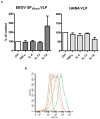Cytokine Effects on the Entry of Filovirus Envelope Pseudotyped Virus-Like Particles into Primary Human Macrophages
- PMID: 31547585
- PMCID: PMC6832363
- DOI: 10.3390/v11100889
Cytokine Effects on the Entry of Filovirus Envelope Pseudotyped Virus-Like Particles into Primary Human Macrophages
Abstract
Macrophages are one of the first and also a major site of filovirus replication and, in addition, are a source of multiple cytokines, presumed to play a critical role in the pathogenesis of the viral infection. Some of these cytokines are known to induce macrophage phenotypic changes in vitro, but how macrophage polarization may affect the cell susceptibility to filovirus entry remains largely unstudied. We generated different macrophage subsets using cytokine pre-treatment and subsequently tested their ability to fuse with beta-lactamase containing virus-like particles (VLP), pseudotyped with the surface glycoprotein of Ebola virus (EBOV) or the glycoproteins of other clinically relevant filovirus species. We found that pre-incubation of primary human monocyte-derived macrophages (MDM) with interleukin-10 (IL-10) significantly enhanced filovirus entry into cells obtained from multiple healthy donors, and the IL-10 effect was preserved in the presence of pro-inflammatory cytokines found to be elevated during EBOV disease. In contrast, fusion of IL-10-treated macrophages with influenza hemagglutinin/neuraminidase pseudotyped VLPs was unchanged or slightly reduced. Importantly, our in vitro data showing enhanced virus entry are consistent with the correlation established between elevated serum IL-10 and increased mortality in filovirus infected patients and also reveal a novel mechanism that may account for the IL-10-mediated increase in filovirus pathogenicity.
Keywords: Ebola virus (EBOV); cytokines; filoviruses; interleukin-10 (IL-10).
Conflict of interest statement
The authors declare no conflict of interest. The funders had no role in the design of the study; in the collection, analyses, or interpretation of data; in the writing of the manuscript, or in the decision to publish the results. This work represents the views of the authors and does not necessarily reflect those of the Food and Drug Administration, the National Institute of Allergy and Infectious Diseases/National Institutes of Health and/or the Uniformed Services University.
Figures










Similar articles
-
A biaryl sulfonamide derivative as a novel inhibitor of filovirus infection.Antiviral Res. 2020 Nov;183:104932. doi: 10.1016/j.antiviral.2020.104932. Epub 2020 Sep 15. Antiviral Res. 2020. PMID: 32946918 Free PMC article.
-
Role of EXT1 and Glycosaminoglycans in the Early Stage of Filovirus Entry.J Virol. 2015 May;89(10):5441-9. doi: 10.1128/JVI.03689-14. Epub 2015 Mar 4. J Virol. 2015. PMID: 25741008 Free PMC article.
-
Identification of filovirus entry inhibitors targeting the endosomal receptor NPC1 binding site.Antiviral Res. 2021 May;189:105059. doi: 10.1016/j.antiviral.2021.105059. Epub 2021 Mar 8. Antiviral Res. 2021. PMID: 33705865 Free PMC article.
-
Filovirus proteins for antiviral drug discovery: A structure/function analysis of surface glycoproteins and virus entry.Antiviral Res. 2016 Nov;135:1-14. doi: 10.1016/j.antiviral.2016.09.001. Epub 2016 Sep 14. Antiviral Res. 2016. PMID: 27640102 Free PMC article. Review.
-
Filovirus entry into cells - new insights.Curr Opin Virol. 2012 Apr;2(2):206-14. doi: 10.1016/j.coviro.2012.02.015. Epub 2012 Mar 23. Curr Opin Virol. 2012. PMID: 22445965 Free PMC article. Review.
Cited by
-
Macrophage infection, activation, and histopathological findings in ebolavirus infection.Front Cell Infect Microbiol. 2022 Oct 12;12:1023557. doi: 10.3389/fcimb.2022.1023557. eCollection 2022. Front Cell Infect Microbiol. 2022. PMID: 36310868 Free PMC article. Review.
-
Hepatic and pulmonary macrophage activity in a mucosal challenge model of Ebola virus disease.Front Immunol. 2024 Nov 20;15:1439971. doi: 10.3389/fimmu.2024.1439971. eCollection 2024. Front Immunol. 2024. PMID: 39635525 Free PMC article.
References
-
- Villinger F., Rollin P.E., Brar S.S., Chikkala N.F., Winter J., Sundstrom J.B., Zaki S.R., Swanepoel R., Ansari A.A., Peters C.J. Markedly elevated levels of interferon (ifn)-gamma, ifn-alpha, interleukin (il)-2, il-10, and tumor necrosis factor-alpha associated with fatal ebola virus infection. J. Infect. Dis. 1999;179(Suppl. 1):S188–S191. doi: 10.1086/514283. - DOI - PubMed
Publication types
MeSH terms
Substances
Grants and funding
LinkOut - more resources
Full Text Sources
Research Materials

